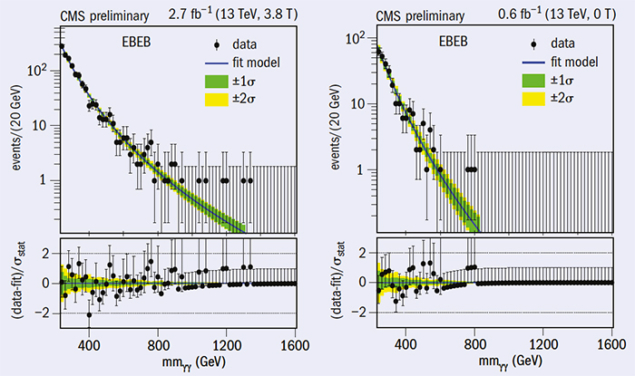In December 2015, just a few weeks after the end of the initial LHC Run 2 period recording proton–proton collisions at the world-record collision energy of 13 TeV, CMS and ATLAS presented several new results based on this novel data. These results were eagerly anticipated: at this centre-of-mass energy, new particles heavier than 1–2 TeV could be produced over 10 times more frequently than during Run 1.

Image credit: CMS Collaboration.
The results presented by CMS were based on a data set corresponding to an integrated luminosity of ~ 2.7 fb–1. Because of the short time between the end of data-taking and the presentation of the results, only preliminary calibrations could be applied. However, these were not all of the data that CMS recorded: an additional 0.6 fb–1 were collected without a magnetic field (0 T data set). The cryogenic plant delivering the necessary liquid helium to operate the superconducting solenoid was disrupted during 2015 by the presence of contaminants. The filters inside of the cryogenic plant had to be regenerated several times, in conjunction with the magnet being ramped down. Before continuing the story of the 0 T data set, we want to reassure the reader that the system underwent an extensive programme of cleaning and maintenance during the end-of-year technical stop, and it is now on track for reliable operation in 2016.
The perfect candidate analysis for these data is the search for resonances in the diphoton final state. Preliminary results for this search, shown by CMS and ATLAS in December 2015, generated significant interest within the high-energy community because of a simultaneous excess of data with respect to the expected background seen by both experiments at a diphoton mass of about 750 GeV.
While the momenta of charged particles require a magnetic field to be measured, the energies of neutral and charged particles can be measured with the CMS electromagnetic and hadronic calorimeters without a magnet. Therefore, although challenging, it is still possible to use data collected without a magnetic field through implementation of special and dedicated reconstruction and selection procedures. Photons are neutral particles, which do not bend in the magnetic field, and their energies are measured with a precision better than 1.5% using the CMS lead-tungstate crystal electromagnetic calorimeter. For the 0 T data set, the energy scale and resolution of the electromagnetic calorimeter were carefully cross-checked and adjusted using electrons from Z-boson decays. The momentum information normally used for the vertex assignment and isolation criteria was substituted at 0 T by track-counting, as was previously done by CMS in the summer of 2015 for the very first publication on the 13 TeV data, which was a study of the hadron multiplicity without a magnetic field.
The inclusion of the 0 T data and the use of optimised calibrations improve the overall expected sensitivity for a narrow resonance at 750 GeV by about 20%. The new results still exhibit an excess at a mass around 750 GeV. The new local significance for a narrow resonance hypothesis is 2.8σ. When combined with the 8 TeV data set from Run 1, the largest excess is observed at 750 GeV with a local significance of 3.4σ, corrected to 1.6σ when accounting for the possibility of a signal appearing anywhere in the explored mass range. The analysis gives similar results for both spin-0 and spin-2 signal hypotheses.
Therefore, even after the final calibration and with slightly more data, an intriguing excess remains. Only additional data will tell us whether this is an early sign of new physics.








